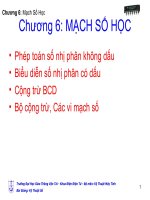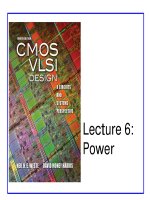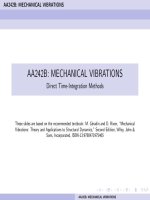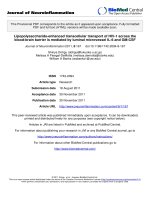Lecture 6 Quantum mechanical spin potx
Bạn đang xem bản rút gọn của tài liệu. Xem và tải ngay bản đầy đủ của tài liệu tại đây (460.8 KB, 23 trang )
Lecture 6
Quantum mechanical spin
Background
Until now, we have focused on quantum mechanics of particles
which are “featureless” – carrying no internal degrees of freedom.
A relativistic formulation of quantum mechanics (due to Dirac and
covered later in course) reveals that quantum particles can exhibit
an intrinsic angular momentum component known as spin.
However, the discovery of quantum mechanical spin predates its
theoretical understanding, and appeared as a result of an ingeneous
experiment due to Stern and Gerlach.
Spin: outline
1
Stern-Gerlach and the discovery of spin
2
Spinors, spin operators, and Pauli matrices
3
Spin precession in a magnetic field
4
Paramagnetic resonance and NMR
Background: expectations pre-Stern-Gerlach
Previously, we have seen that an electron bound to a proton carries
an orbital magnetic moment,
µ = −
e
2m
e
ˆ
L ≡−µ
B
ˆ
L/, H
int
= −µ · B
For the azimuthal component of the wavefunction, e
imφ
, to remain
single-valued, we further require that the angular momentum
takes only integer values (recall that − ≤ m ≤ ).
When a beam of atoms are passed through an inhomogeneous (but
aligned) magnetic field, where they experience a force,
F = ∇(µ · B) µ
z
(∂
z
B
z
)
ˆ
e
z
we expect a splitting into an odd integer (2 + 1) number of beams.
Stern-Gerlach experiment
In experiment, a beam of silver atoms were passed through
inhomogeneous magnetic field and collected on photographic plate.
Since silver involves spherically symmetric charge distribution plus
one 5s electron, total angular momentum of ground state has L = 0.
If outer electron in 5p state, L = 1 and the beam should split in 3.
Stern-Gerlach experiment
However, experiment showed a bifurcation of beam!
Gerlach’s postcard, dated 8th February 1922, to Niels Bohr
Since orbital angular momentum can take only integer values, this
observation suggests electron possesses an additional intrinsic
“ =1/2” component known as spin.
Quantum mechanical spin
Later, it was understood that elementary quantum particles can be
divided into two classes, fermions and bosons.
Fermions (e.g. electron, proton, neutron) possess half-integer spin.
Bosons (e.g. mesons, photon) possess integral spin (including zero).
Spinors
Space of angular momentum states for spin s =1/2
is two-dimensional:
|s =1/2, m
s
=1/2 = | ↑, |1/2, −1/2 = | ↓
General spinor state of spin can be written as linear combination,
α| ↑ + β| ↓ =
α
β
, |α|
2
+ |β|
2
=1
Operators acting on spinors are 2 × 2 matrices. From definition of
spinor, z-component of spin represented as,
S
z
=
1
2
σ
z
,σ
z
=
10
0 −1
i.e. S
z
has eigenvalues ±/2 corresponding to
1
0
and
0
1
.
Spin operators and Pauli matrices
From general formulae for raising/lowering operators,
ˆ
J
+
|j, m =
j(j + 1) − m(m + 1) |j, m +1,
ˆ
J
−
|j, m =
j(j + 1) − m(m − 1) |j, m − 1
with S
±
= S
x
± iS
y
and s =1/2, we have
S
+
|1/2, −1/2 = |1/2, 1/2, S
−
|1/2, 1/2 = |1/2, −1/2
i.e., in matrix form,
S
x
+ iS
y
= S
+
=
01
00
, S
x
− iS
y
= S
−
=
00
10
.
Leads to Pauli matrix representation for spin 1/2, S =
1
2
σ
σ
x
=
01
10
,σ
y
=
0 −i
i 0
,σ
z
=
10
0 −1
Pauli matrices
σ
x
=
01
10
,σ
y
=
0 −i
i 0
,σ
z
=
10
0 −1
Pauli spin matrices are Hermitian, traceless, and obey defining
relations (cf. general angular momentum operators):
σ
2
i
= I, [σ
i
,σ
j
]=2i
ijk
σ
k
Total spin
S
2
=
1
4
2
σ
2
=
1
4
2
i
σ
2
i
=
3
4
2
I =
1
2
(
1
2
+ 1)
2
I
i.e. s(s + 1)
2
, as expected for spin s =1/2.
Spatial degrees of freedom and spin
Spin represents additional internal degree of freedom, independent
of spatial degrees of freedom, i.e. [
ˆ
S, x]=[
ˆ
S,
ˆ
p]=[
ˆ
S,
ˆ
L] = 0.
Total state is constructed from direct product,
|ψ =
d
3
x (ψ
+
(x)|x ⊗ | ↑ + ψ
−
(x)|x ⊗ | ↓) ≡
|ψ
+
|ψ
−
In a weak magnetic field, the electron Hamiltonian can then be
written as
ˆ
H =
ˆ
p
2
2m
+ V (r)+µ
B
ˆ
L/ + σ
· B
Relating spinor to spin direction
For a general state α| ↑ + β| ↓, how do α, β relate to
orientation of spin?
Let us assume that spin is pointing along the unit vector
ˆ
n = (sin θ cos ϕ, sin θ sin ϕ, cos θ), i.e. in direction (θ, ϕ).
Spin must be eigenstate of
ˆ
n · σ with eigenvalue unity, i.e.
n
z
n
x
− in
y
n
x
+ in
y
−n
z
α
β
=
α
β
With normalization, |α|
2
+ |β|
2
= 1, (up to arbitrary phase),
α
β
=
e
−iϕ/2
cos(θ/2)
e
iϕ/2
sin(θ/2)
Spin symmetry
α
β
=
e
−iϕ/2
cos(θ/2)
e
iϕ/2
sin(θ/2)
Note that under 2π rotation,
α
β
→ −
α
β
In order to make a transformation that returns spin to starting
point, necessary to make two complete revolutions, (cf. spin 1
which requires 2π and spin 2 which requires only π!).
(Classical) spin precession in a magnetic field
Consider magnetized object spinning about centre of mass, with angular
momentum L and magnetic moment µ = γL with γ gyromagnetic ratio.
A magnetic field B will then impose a torque
T = µ × B = γL × B = ∂
t
L
With B = B
ˆ
e
z
, and L
+
= L
x
+ iL
y
, ∂
t
L
+
= −iγBL
+
,
with the solution L
+
= L
0
+
e
−iγBt
while ∂
t
L
z
= 0.
Angular momentum vector L precesses about magnetic field
direction with angular velocity ω
0
= −γB (independent of angle).
We will now show that precisely the same result appears in the study
of the quantum mechanics of an electron spin in a magnetic field.
(Quantum) spin precession in a magnetic field
Last lecture, we saw that the electron had a magnetic moment,
µ
orbit
= −
e
2m
e
ˆ
L, due to orbital degrees of freedom.
The intrinsic electron spin imparts an additional contribution,
µ
spin
= γ
ˆ
S, where the gyromagnetic ratio,
γ = −g
e
2m
e
and g (known as the Land´e g -factor) is very close to 2.
These components combine to give the total magnetic moment,
µ = −
e
2m
e
(
ˆ
L + g
ˆ
S)
In a magnetic field, the interaction of the dipole moment is given by
ˆ
H
int
= −µ · B
(Quantum) spin precession in a magnetic field
Focusing on the spin contribution alone,
ˆ
H
int
= −γ
ˆ
S · B = −
γ
2
σ · B
The spin dynamics can then be inferred from the time-evolution
operator, |ψ(t) =
ˆ
U(t)|ψ(0), where
ˆ
U(t)=e
−i
ˆ
H
int
t/
= exp
i
2
γσ · Bt
However, we have seen that the operator
ˆ
U(θ) = exp[−
i
θ
ˆ
e
n
·
ˆ
L]
generates spatial rotations by an angle θ about
ˆ
e
n
.
In the same way,
ˆ
U(t) effects a spin rotation by an angle −γBt
about the direction of B!
(Quantum) spin precession in a magnetic field
ˆ
U(t)=e
−i
ˆ
H
int
t/
= exp
i
2
γσ · Bt
Therefore, for initial spin configuration,
α
β
=
e
−iϕ/2
cos(θ/2)
e
iϕ/2
sin(θ/2)
With B = B
ˆ
e
z
,
ˆ
U(t) = exp[
i
2
γBtσ
z
], |ψ(t) =
ˆ
U(t)|ψ(0),
α(t)
β(t)
=
e
−
i
2
ω
0
t
0
0 e
i
2
ω
0
t
α
β
=
e
−
i
2
(ϕ+ω
0
t)
cos(θ/2)
e
i
2
(ϕ+ω
0
t)
sin(θ/2)
i.e. spin precesses with angular frequency ω
0
= −γB = −g ω
c
ˆ
e
z
,
where ω
c
=
eB
2m
e
is cyclotron frequency,(
ω
c
B
10
11
rad s
−1
T
−1
).
Paramagnetic resonance
This result shows that spin precession
frequency is independent of spin orientation.
Consider a frame of reference which is itself
rotating with angular velocity ω about
ˆ
e
z
.
If we impose a magnetic field B
0
= B
0
ˆ
e
z
, in the rotating frame, the
observed precession frequency is ω
r
= −γ(B
0
+ ω/γ), i.e. an
effective field B
r
= B
0
+ ω/γ acts in rotating frame.
If frame rotates exactly at precession frequency, ω = ω
0
= −γB
0
,
spins pointing in any direction will remain at rest in that frame.
Suppose we now add a small additional component of the magnetic
field which is rotating with angular frequency ω in the xy plane,
B = B
0
ˆ
e
z
+ B
1
(
ˆ
e
x
cos(ωt) −
ˆ
e
y
sin(ωt))
Paramagnetic resonance
B = B
0
ˆ
e
z
+ B
1
(
ˆ
e
x
cos(ωt) −
ˆ
e
y
sin(ωt))
Effective magnetic field in a frame rotating with same frequency ω
as the small added field is B
r
=(B
0
+ ω/γ)
ˆ
e
z
+ B
1
ˆ
e
x
If we tune ω so that it exactly matches the precession frequency in
the original magnetic field, ω = ω
0
= −γB
0
, in the rotating frame,
the magnetic moment will only see the small field in the x-direction.
Spin will therefore precess about x-direction at slow angular
frequency γB
1
– matching of small field rotation frequency with
large field spin precession frequency is “resonance”.
Nuclear magnetic resonance
The general principles exemplified by paramagnetic resonance
underpin methodology of Nuclear magnetic resonance (NMR).
NMR principally used to determine structure of molecules in
chemistry and biology, and for studying condensed matter in solid or
liquid state.
Method relies on nuclear magnetic moment of atomic nucleus,
µ = γ
ˆ
S
e.g. for proton γ = g
P
e
2m
p
where g
p
=5.59.
Nuclear magnetic resonance
In uniform field, B
0
, nuclear spins occupy
equilibrium thermal distibution with
P
↑
P
↓
= exp
ω
0
k
B
T
,ω
0
= γB
0
i.e. (typically small) population imbalance.
Application of additional oscillating resonant in-plane magnetic field
B
1
(t) for a time, t, such that
ω
1
t =
π
2
,ω
1
= γB
1
(“π/2 pulse”) orients majority spin in xy-plane where it precesses at
resonant frequency allowing a coil to detect a.c. signal from induced
e.m.f.
Return to equilibrium set by transverse relaxation time, T
2
.
Nuclear magnetic resonance
Resonance frequency depends on
nucleus (through γ) and is slightly
modified by environment splitting.
In magnetic resonance imaging (MRI), focus is on
proton in water and fats. By using non-uniform field,
B
0
, resonance frequency can be made position
dependent – allows spatial structures to be recovered.
Summary: quantum mechanical spin
In addition to orbital angular momentum,
ˆ
L, quantum particles
possess an intrinsic angular momentum known as spin,
ˆ
S.
For fermions, spin is half-integer while, for bosons, it is integer.
Wavefunction of electron expressed as a two-component spinor,
|ψ =
d
3
x (ψ
+
(x)|x ⊗ | ↑ + ψ
−
(x)|x ⊗ | ↓) ≡
|ψ
+
|ψ
−
In a weak magnetic field,
ˆ
H =
ˆ
p
2
2m
+ V (r)+µ
B
ˆ
L/ +
g
2
σ
· B
Spin precession in a uniform field provides basis of paramagnetic
resonance and NMR.









